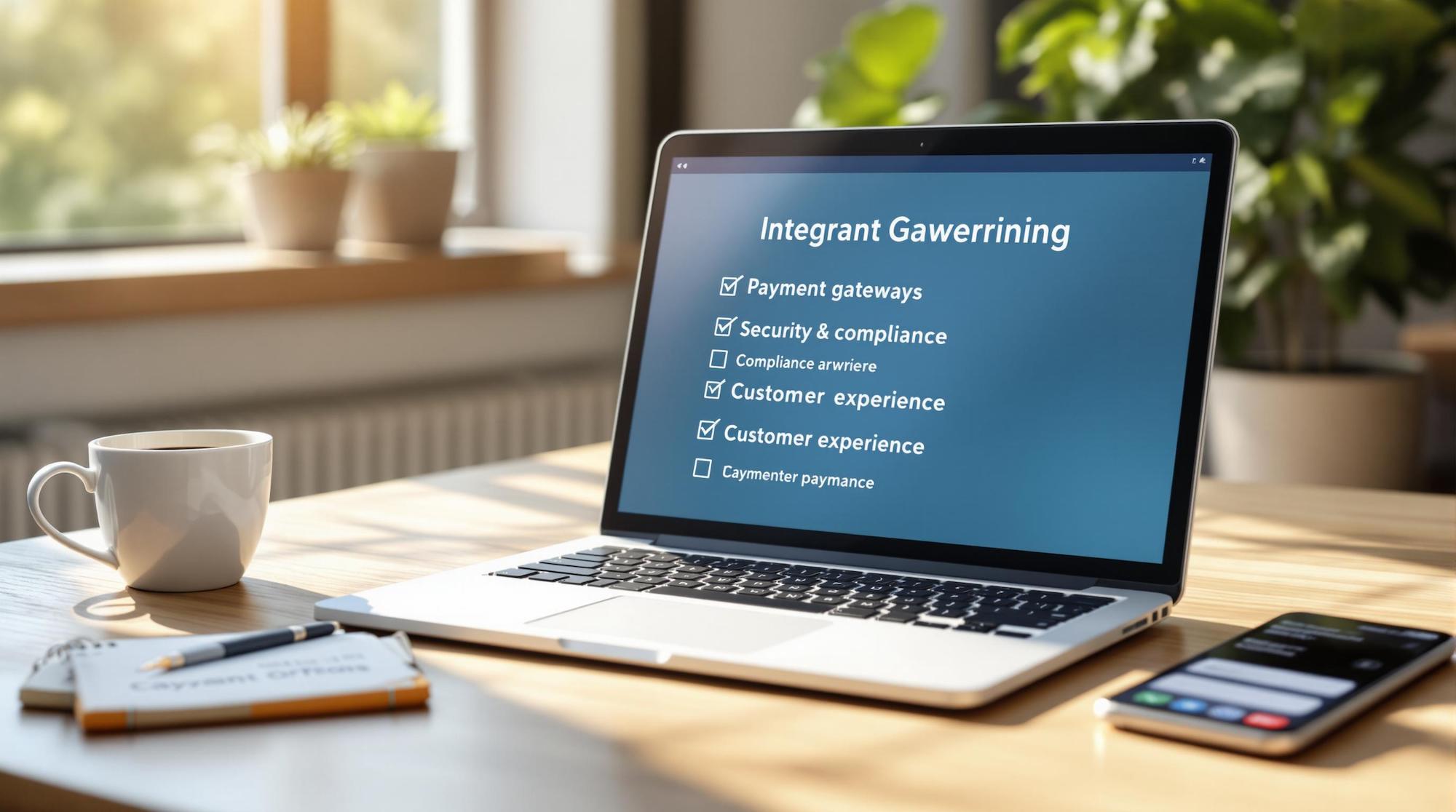Want to integrate a payment gateway for your online business but don’t know where to start? This checklist breaks down the process into simple steps, ensuring secure transactions, smooth customer experiences, and compliance with industry standards. Here’s what you’ll learn:
- Platform Compatibility: Ensure your gateway works with Shopify, WooCommerce, Magento, or your platform.
- Security Standards: Meet PCI compliance, use encryption, and protect sensitive customer data.
- Testing & Launch: Test payments in a sandbox, handle errors, and gradually go live.
- Payment Methods: Support credit cards, digital wallets, and regional payment preferences.
- Monitoring & Maintenance: Track success rates, fix issues, and scale for growth.
Key takeaway: A well-planned integration boosts customer trust and reduces payment failures. Follow this step-by-step guide to get it right the first time.
What is a payment gateway and how does it work?
Step 1: Pre-Integration Planning
Proper planning is key to avoiding mistakes during integration. This step focuses on confirming platform compatibility and outlining your payment processing needs.
Check Platform Support
Make sure your payment gateway works seamlessly with your e-commerce platform. Platforms like Shopify, WooCommerce, and Magento each come with specific integration options and requirements.
| Platform | Integration Options | Key Considerations |
|---|---|---|
| Shopify | Native plugins, API | Pre-built solutions from providers like Stripe and PayPal |
| WooCommerce | Payment extensions | Direct gateway plugins and custom API integration |
| Magento | Payment modules | Enterprise-level security features |
For instance, Stripe offers ready-to-use plugins that can save time and simplify the process for developers.
Once you confirm compatibility, move on to defining your payment processing needs.
List Business Requirements
Clearly document what you need from your payment gateway. Focus on these areas:
-
Transaction Volume:
Payment gateways often adjust pricing and support based on how many transactions your business processes. -
Payment Methods:
Identify the payment options your customers expect. Most businesses today need to support a variety of methods:Payment Type Market Coverage Credit/Debit Cards Widely used worldwide Digital Wallets Increasingly popular with mobile users Local Payment Methods Tailored to specific regions Buy Now, Pay Later Gaining traction as a payment choice -
Geographic Needs:
If your business operates globally, ensure the gateway supports cross-border transactions, multiple currencies, and local payment preferences. Also, check for compliance with regional standards.
Step 2: Technical Setup Steps
Now it’s time to dive into the technical setup: review the API documentation, set up a sandbox environment, and create your payment interface.
Read API Documentation
Start by thoroughly reviewing the API documentation to understand how to interact with the payment gateway. This includes endpoints, authentication methods, and handling responses.
| Documentation Component | Purpose | Key Focus Areas |
|---|---|---|
| API Endpoints | Define interaction points | Payment processing, refunds, transaction status |
| Authentication Methods | Secure API access | API keys, OAuth tokens, encryption requirements |
| Response Handling | Process gateway responses | Success/failure codes, error handling |
A great example is Stripe’s API documentation, which offers detailed guides and code samples. It simplifies the development process by covering everything from payment scenarios to security protocols.
Create Test Environment
Set up a sandbox environment to test payment flows in a risk-free setting.
| Testing Phase | Purpose | Tools/Resources |
|---|---|---|
| Initial Setup | Configure test credentials | Sandbox accounts from the payment gateway |
| Transaction Testing | Validate payment flows | Test card numbers, simulation tools |
| Error Handling | Verify error responses | Simulated failed transaction scenarios |
Your sandbox should closely replicate your production environment. Most payment gateways provide tools and sample data to help simulate real-world payment scenarios, making it easier to identify and fix issues before going live.
Build Payment Interface
Now, create a secure and user-friendly payment interface that protects sensitive data on both the front and back ends.
Key points to focus on:
- Form Security: Use client-side validation and encrypt data before sending it to the server.
- Mobile Responsiveness: Ensure the interface works smoothly across all devices.
- Error Management: Offer clear and actionable feedback for transaction issues.
On the server side, prioritize encryption, tokenization, and secure API protocols. Following the security guidelines provided by your payment gateway is essential. For example, AWS API Gateway outlines best practices for meeting PCI DSS compliance and safeguarding payment interfaces.
The goal is to design a checkout experience that’s both secure and easy to use. A smooth process reduces cart abandonment while keeping transactions safe.
Step 3: Security Standards
Strong security standards are the backbone of reliable payment processing. Once your secure payment interface is in place, adhering to strict standards like PCI compliance and integrating advanced security measures helps protect your business from potential threats.
Meet PCI Standards
If your business handles credit card transactions, complying with the Payment Card Industry Data Security Standard (PCI DSS) is a must. Ignoring these standards can lead to fines of up to $500,000 and the loss of your ability to process credit card payments.
| Compliance Component | Required Actions | How to Verify |
|---|---|---|
| Network Security | Build and maintain secure networks | Conduct regular scans |
| Data Protection | Use encryption and tokenization | Perform audits or self-checks |
| Access Control | Restrict access to systems | Review authentication logs |
| System Monitoring | Monitor all network access | Use continuous monitoring tools |
To achieve PCI DSS compliance, follow these key steps:
- Assessment: Regularly audit your payment systems for vulnerabilities.
- Documentation: Maintain detailed records of all security protocols and measures.
- Validation: Complete the appropriate Self-Assessment Questionnaire (SAQ) for your business type.
- Certification: Obtain formal certification if your business level requires it.
Going beyond PCI compliance by implementing additional layers of security can provide even greater protection for your payment systems.
Add Security Features
Modern payment systems rely on multiple layers of defense to ensure security. Consider integrating these essential features:
| Security Feature | Purpose | Priority |
|---|---|---|
| Tokenization | Replaces card data with secure tokens | High |
| End-to-end Encryption | Protects data during transmission | High |
| Fraud Detection | Identifies and stops suspicious activity | Medium |
| Access Controls | Limits access to sensitive systems | Medium |
A great example of effective security is Akurateco‘s payment software. By achieving PCI DSS Level 1 certification, they incorporated advanced security measures across over 300 payment integrations. This shows how scalable security solutions can ensure compliance while maintaining functionality.
To further strengthen your payment system, take these steps:
- Encryption Protocols: Use industry-standard encryption to secure transactions.
- Multi-factor Authentication: Require additional verification for administrative access.
- Regular Updates: Keep all security tools and software up to date.
While implementing these measures, aim for a balance between strong security and an easy-to-use interface. Your payment system should remain secure without compromising customer experience.
sbb-itb-8c45743
Step 4: Testing and Launch
Carefully test and launch your payment gateway to ensure smooth transactions and quickly address any issues.
Once security measures are in place, check transaction flows right away.
Run Payment Tests
Stripe’s documentation suggests using test credentials to mimic various transaction scenarios and confirm the system’s reliability.
| Test Scenario | Purpose | Key Checks |
|---|---|---|
| Successful Payments | Check standard transaction flow | Authorization, capture, receipt generation |
| Failed Transactions | Ensure proper error handling | Error messaging, decline handling, retry logic |
| Refund Processing | Validate the refund process | Full/partial refunds and settlement procedures |
| High-Volume Load | Test stability under heavy usage | Response times and handling of multiple transactions |
Using a sandbox environment helps identify potential issues before going live. To finish your integration checklist, complete these steps:
- Test various payment methods.
- Simulate error scenarios.
- Confirm webhook responses and payment status updates.
Launch Live Payments
Roll out live payments gradually while keeping a close eye on performance.
Start with a controlled launch, processing a small percentage of your transactions. Monitor key metrics to ensure the system is stable before scaling up to full capacity.
| Metric | Monitoring Focus | Action if Issues Arise |
|---|---|---|
| Transaction Success Rate | Confirm most transactions succeed | Review error handling if success rates drop |
| Processing Time | Ensure consistent performance | Investigate network or system delays |
| Error Rate | Minimize operational errors | Analyze error logs to fix problems |
| Chargeback Volume | Keep chargebacks low | Reevaluate fraud prevention measures |
Have your support team ready during the initial live phase. Set up automated alerts for unusual patterns, such as spikes in failed transactions or processing delays.
Verify live performance by comparing metrics to your integration checklist. Once live payments are stable, shift focus to ongoing maintenance to keep the system running smoothly.
Step 5: Payment System Maintenance
Once your payment system is live, keeping it running smoothly requires ongoing monitoring and adjustments.
Keep an Eye on Payment Data
Regularly check transaction success rates, processing times, and error trends. A drop in successful transactions or a rise in errors might signal issues with your payment gateway or processing system. Most payment gateways offer analytics tools – use these to create reports on transaction activity and quickly identify any bottlenecks.
Key metrics to monitor include:
- Transaction volumes
- Success rates by payment method
- Error occurrences
- Server response times
Prepare for Growth
Ensure your system can handle increasing traffic and transaction volumes. This means optimizing server capacity, fine-tuning database performance, and ensuring API connections are efficient. Cloud services can help by providing flexible resources during traffic spikes. Regularly evaluate your system’s capacity and update security measures to stay aligned with industry standards.
Important steps for scaling include monitoring server load, using caching solutions, building redundancy, and keeping reliable backups in place.
Integration Checklist Summary
To achieve smooth and efficient integration, careful planning is key. Here’s a quick overview of the essential steps to ensure reliable payment processing.
First, check that your platform is compatible to avoid unnecessary delays or issues. Building a strong foundation for payment processing should be your top priority.
Security is non-negotiable – PCI compliance is a must to safeguard sensitive data and avoid penalties. Key actions include:
- Encrypting data
- Using tokenization
- Conducting regular audits
- Training staff on security protocols
Leverage pre-built plugins to simplify the process while maintaining a secure setup. Combining technical precision with robust security measures ensures dependable payment processing.
Your Integration Checklist:
- Platform Compatibility: Confirm system requirements and available technical support.
- Security Standards: Put PCI compliance and encryption measures in place.
- Testing Protocol: Use sandbox environments for thorough pre-deployment testing.
- Monitoring Systems: Set up tools to track transactions effectively.
- Maintenance Plan: Schedule periodic security reviews and updates.
Each step is designed to build on the last, creating a solid framework for secure and efficient payment operations. Regularly revisiting these steps will help maintain system reliability and compliance.
FAQs
Do payment gateways need to be PCI compliant?
Yes, any business handling credit card payments must follow PCI compliance rules, even when using a payment gateway. Merchants are still responsible for safeguarding cardholder data, making compliance a must.
Here’s how to stay PCI compliant:
- Certified Providers: Choose gateways approved by the PCI Security Standards Council.
- Security Measures: Use tools like encryption and tokenization to protect data.
- Regular Audits: Conduct yearly reviews and assessments to ensure compliance.
"Non-compliance with PCI standards can result in fines up to $500,000 per incident, penalties, and even revocation of the right to accept credit cards."
Small businesses are often targeted, so taking extra steps to secure payment processes is crucial. Beyond meeting compliance requirements, consider these practices:
- Use secure checkout pages to minimize direct exposure to sensitive information.
- Process transactions with secure tokens to add an extra layer of protection.
- Ensure all payment operations use encrypted connections.
These methods work alongside the PCI standards and security measures discussed earlier to help reduce risks and protect your business.




